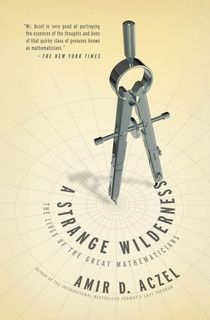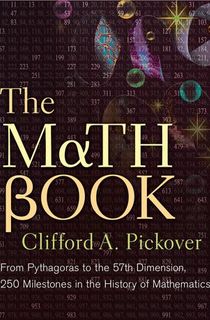Math is everywhere. It pervades every aspect of the natural world, and yet is so often ignored or taken for granted. Educating oneself about the history of math can be an eye-opening experience, one that changes the ways in which the reader sees the world around them. While even these comprehensive books can’t possibly cover the entire history of math, they comprise an excellent reading list to get the burgeoning mathematician started.

Zero: The Biography of a Dangerous Idea
In the modern day, it’s easy to be fooled into thinking the concept of zero always existed. However, as Charles Seife recounts in his Zero: The Biography of a Dangerous Idea, zero once had to be invented. In fact, it dates back to the complicated system of Babylonian mathematics, and things didn’t get any easier from there.
Zero has had a difficult journey up to the present, having been banned in Ancient Greece and later, becoming an existential threat to the science of physics. Seife’s book explores how easily something like the number zero can throw a wrench in the works, like when it wanders its way into an unsuspecting division problem. It also discusses the religious aspect of zero, and how it relates to the philosophy of nothingness.

Equations from God
Most think of math in terms of its practical applications: its implications for industry, finance, the sciences, etc. But in Ancient Greece, math was more closely related to the abstract, and was often used as a means to communicate with the divine. However, this conception of divine math later disappeared from history for a time, only to reappear during the Victorian period in England.
It’s this resurgence in spiritual math that constitutes the subject of Daniel J. Cohen’s Equations from God. Cohen covers Victorian England’s obsession with the spiritual, which created the perfect backdrop for a revival of spiritual math. These developments went on to influence schools of secular philosophy. Ultimately, Cohen arrives at a theory of the simple purity of mathematical law, and discusses its potential use as a conduit to transcend reality and understand the spiritual.

A Strange Wilderness
It takes a unique mindset to be a trailblazing mathematician, so it’s no surprise that many of these historical figures led remarkable lives even outside pencil and paper. In A Strange Wilderness, Amir D. Aczel collects anecdotes from the lives of great mathematicians throughout history. Discussing Archimedes nude run through the streets on discovering the principle of displacement, René Descartes’ days as a wandering swordsman, and Alexander Grothendieck’s disappearance into the Pyrennees, Aczel paints a portrait of the archetypal mathematician: intelligent, bold, and inscrutably eccentric. By turns funny, tragic, mysterious, and sometimes downright strange, A Strange Wilderness cobbles together a history of mathematics through the lives of the people who shaped it.

The Math Book
Clifford A. Pickover’s The Math Book is probably the most comprehensive tome of mathematical history in print today. It describes 250 great moments in mathematical history, spanning the millennia between prehistory and the 21st century. Through its portrayal of such momentous occasions as the world’s first roll of dice, the discovery of the Pythagorean theorem, the writing of Omar Khayyam’s Treatise, Newton’s development of calculus, the creation of the Rubik’s cube, and the plotting of a perfect game of checkers, Pickover’s Math Book demonstrates just how long the history of math is, and how much it’s developed since humanity’s early days. It also examines how pervasive math is in our daily lives, how it pertains to every aspect of the natural world even when we aren’t aware of it. To round out the collection, Pickover has also written a Physics Book and a Science Book with similar conceits.

Hidden Figures
Before the invention of machine computers, all mathematical calculations—even the most complicated ones with the least room for error—had to be done by hand. Margot Lee Shetterly’s Hidden Figures covers the lives of three Black women who performed this indispensable work: Mary Jackson, Katherine Johnson, and Dorothy Vaughan, who worked as human computers for NASA and NACA (the National Advisory Committee for Aeronautics).
Despite the vitality of their work to national defense and air-space endeavors, all three women faced misogyny and racism in the workplace. Hidden Figures follows the work of Jackson, Johnson, and Vaughan between the 1930s and 1960s, demonstrating the importance of their calculations to NASA and NACA’s successes, including the Mercury and Apollo missions. It reminds the reader that mathematical advancements aren’t just the product of a few great men that we've been told about—they’re also dependent on hundreds of unnamed individuals who had to check their work.

Fermat’s Last Theorem
When the 17th-century mathematician Pierre de Fermat scribbled a curious little equation into the margins of his copy of Diophantus’ Arithmetica, he likely didn’t consider that the problem would baffle mathematicians for centuries to come. Fermat’s Last Theorem by Simon Singh covers a 350-year journey to prove a deceptively difficult theorem, and the various attempts that went into solving it. After many missteps, including those by the 19th-century French mathematical mind Évariste Galois, by the mid-20th century, most had accepted that Fermat’s theorem was just conjecture and would never be solved.
But the English mathematician Sir Andrew Wiles picked up where others had left off, tying in several other independent discoveries to produce a comprehensive and accurate proof of Fermat’s last theorem. The result had resounding implications for the field of mathematics in general, and for his efforts, Wiles won an Abel Prize. By the end of Fermat’s Last Theorem, the reader will realize it’s less so a story of an unsolvable problem, and more one of the unflappable determination of a brilliant mind.

The Man Who Loved Only Numbers
Paul Hoffman’s The Man Who Loved Only Numbers is the definitive biography of Paul Erdős, a brilliant Hungarian mathematician and wholly unique individual. Born in 1913, Erdős endured childhood hardship and anti-Semitism in his early career, but made an early impression by finding a simple proof for Bertrand’s postulate by the age of 20. Throughout his life, he would offer up many of his own problems for others to solve, which he designed to be just out of reach of the day’s most preeminent mathematicians.
Erdős is remembered not only for his unique approach and mathematical brilliance, but for his kindness toward his peers, which is well documented in Hoffman’s biography. Erdős had an unusual approach to mathematics, believing it to be primarily a social endeavor. Throughout his life, he collaborated with over 500 others on over 1,000 mathematical papers; the Erdős number, like an academic game of six degrees of separation, became a playful measure of a mathematician’s collaborative distance from him. Also, for those interested in mathematical history but daunted by the possibility of encountering technical jargon, The Man Who Loved Only Numbers is written so as to be accessible even to those who are not expert mathematicians.
Featured image: Derrick Treadwell / Unsplash



